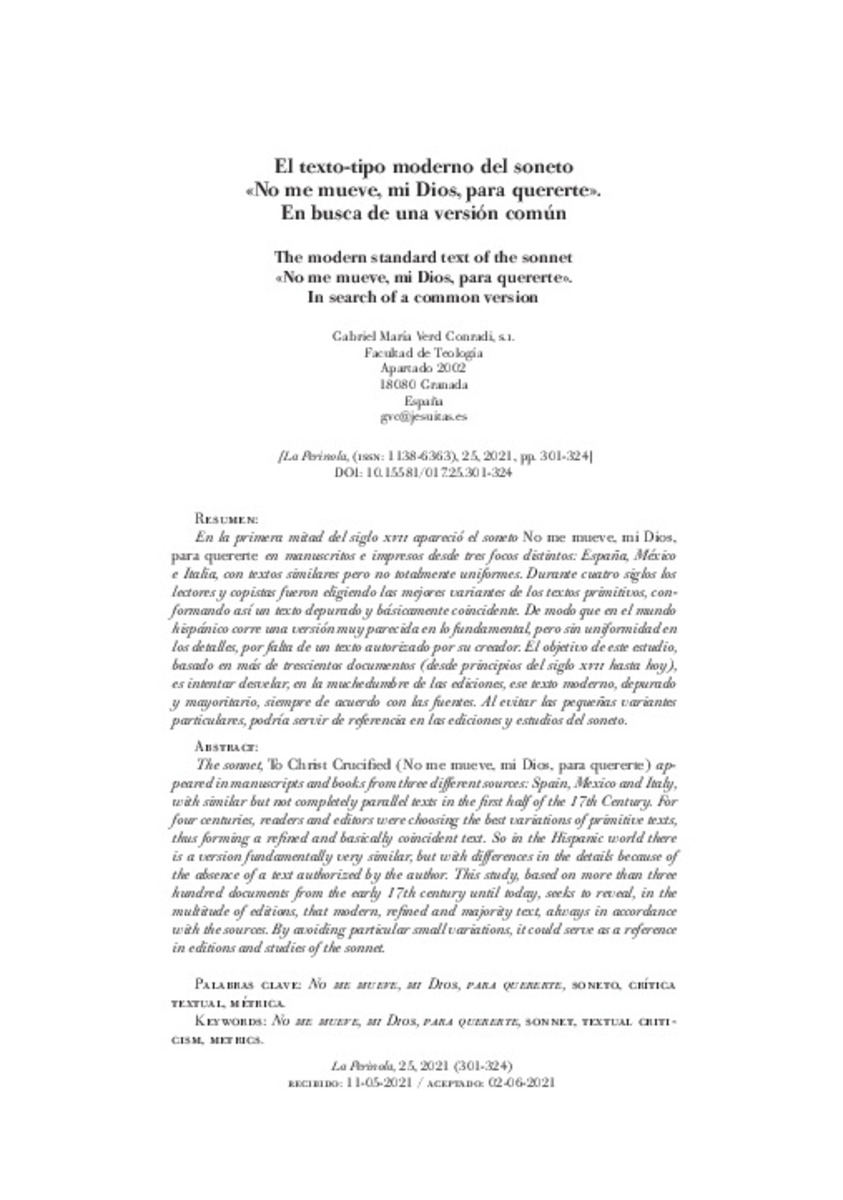Full metadata record
| DC Field | Value | Language |
|---|---|---|
| dc.creator | Verd-Conradi, G.M. (Gabriel María) | - |
| dc.date.accessioned | 2021-06-15 | - |
| dc.date.accessioned | 2023-06-09T10:10:41Z | - |
| dc.date.available | 2023-06-09T10:10:41Z | - |
| dc.date.issued | 2021 | - |
| dc.identifier.citation | Verd-Conradi, G.M. (Gabriel María). "El texto-tipo moderno del soneto «No me mueve, mi Dios, para quererte». En busca de una versión común". La Perinola. 25, 2021, 301 - 324 | es |
| dc.identifier.issn | 1138-6363 | - |
| dc.identifier.uri | https://hdl.handle.net/10171/66587 | - |
| dc.description.abstract | The sonnet, <em>To Christ Crucified</em> (<em>No me mueve, mi Dios, para quererte</em>) appeared in manuscripts and books from three different sources: Spain, Mexico and Italy, with similar but not completely parallel texts in the first half of the 17th Century. For four centuries, readers and editors were choosing the best variations of primitive texts, thus forming a refined and basically coincident text. So in the Hispanic world there is a version fundamentally very similar, but with differences in the details because of the absence of a text authorized by the author. This study, based on more than three hundred documents from the early 17th century until today, seeks to reveal, in the multitude of editions, that modern, refined and majority text, always in accordance with the sources. By avoiding particular small variations, it could serve as a reference in editions and studies of the sonnet. | en_US |
| dc.description.abstract | En la primera mitad del siglo XVII apareció el soneto <em>No me mueve, mi Dios, para quererte</em> en manuscritos e impresos desde tres focos distintos: España, México e Italia, con textos similares pero no totalmente uniformes. Durante cuatro siglos los lectores y copistas fueron eligiendo las mejores variantes de los textos primitivos, conformando así un texto depurado y básicamente coincidente. De modo que en el mundo hispánico corre una versión muy parecida en lo fundamental, pero sin uniformidad en los detalles, por falta de un texto autorizado por su creador. El objetivo de este estudio, basado en más de trescientos documentos (desde principios del siglo XVII hasta hoy), es intentar desvelar, en la muchedumbre de las ediciones, ese texto moderno, depurado y mayoritario, siempre de acuerdo con las fuentes. Al evitar las pequeñas variantes particulares, podría servir de referencia en las ediciones y estudios del soneto. | es_ES |
| dc.language.iso | spa | - |
| dc.publisher | Servicio de Publicaciones de la Universidad de Navarra | es_ES |
| dc.rights | info:eu-repo/semantics/openAccess | es_ES |
| dc.subject | No me mueve | - |
| dc.subject | mi Dios | - |
| dc.subject | para quererte | - |
| dc.subject | soneto | - |
| dc.subject | crítica textual | - |
| dc.subject | métrica | - |
| dc.title | El texto-tipo moderno del soneto «No me mueve, mi Dios, para quererte». En busca de una versión común | es_ES |
| dc.title.alternative | The modern standard text of the sonnet «No me mueve, mi Dios, para quererte». In search of a common version | en_US |
| dc.type | info:eu-repo/semantics/article | es_ES |
| dc.identifier.doi | 10.15581/017.25.301-324 | - |
| dadun.citation.endingPage | 324 | - |
| dadun.citation.publicationName | La Perinola | - |
| dadun.citation.startingPage | 301 | - |
| dadun.citation.volume | 25 | - |
Files in This Item:
Statistics and impact
Items in Dadun are protected by copyright, with all rights reserved, unless otherwise indicated.






